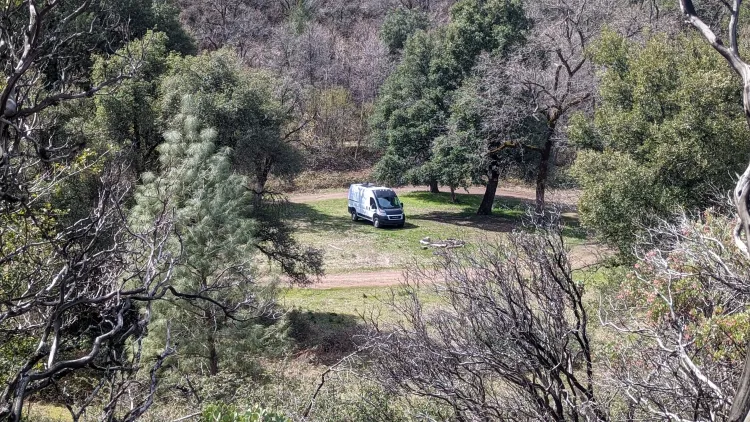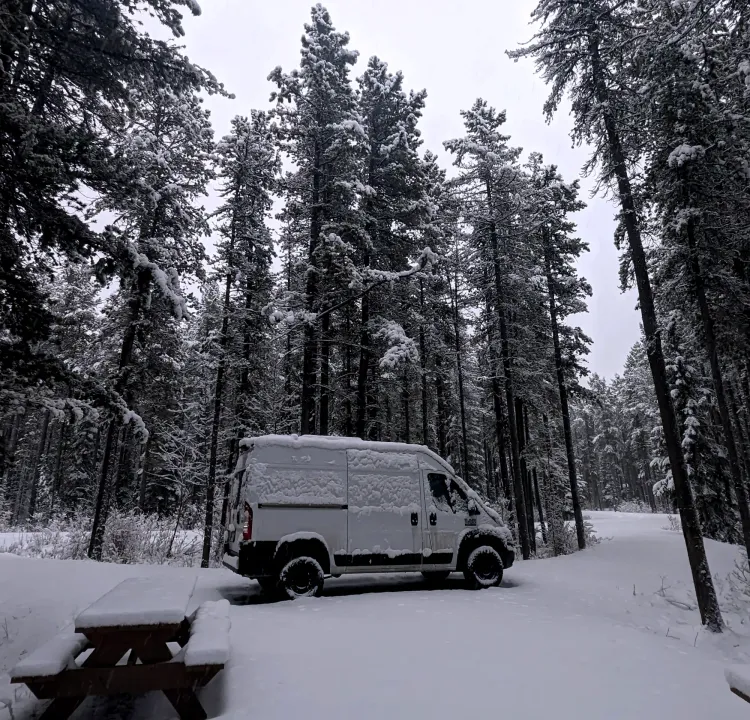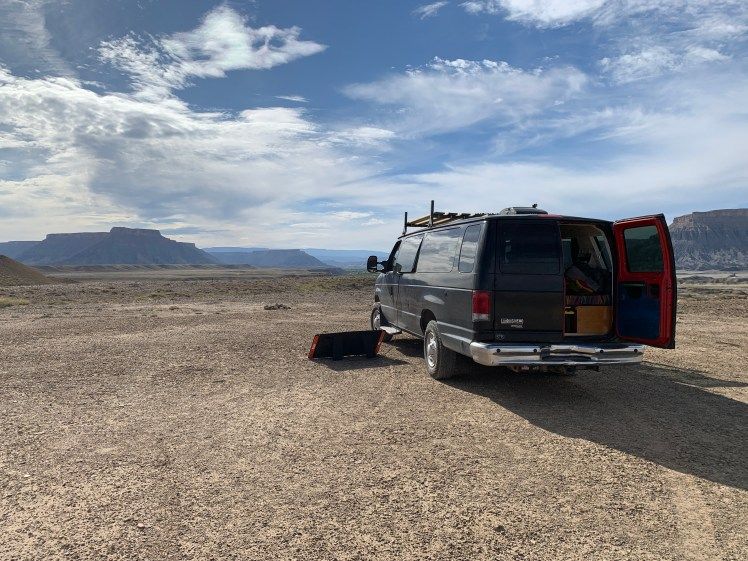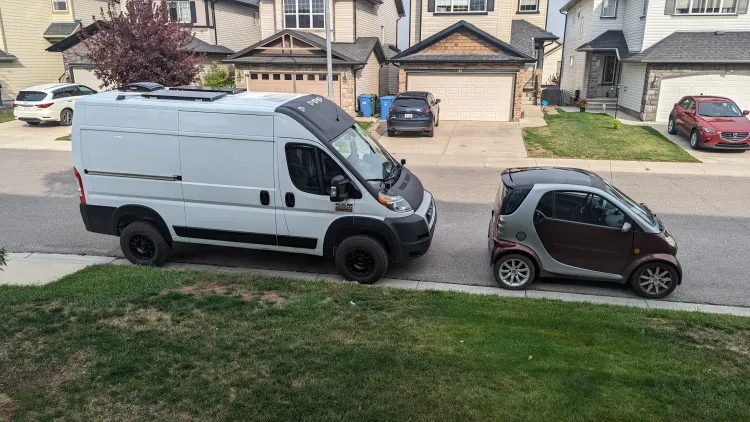Can You Live In A Van In The Winter? Tips and Strategies for Winter Van Life.

Yes, it is possible to live in your van during the winter. Many people live in their vans during the winter for a multitude of reasons. While it may be challenging, there are lots of things you can do to make your winter van life more enjoyable.
Whether you're a skier chasing powder or an employee who needs to stay close to work, it's possible to brave the elements in your van.
Throughout this article, we'll look into everything you need to know to make living in a van during winter a reality.
Let's get into it.
Table Of Contents
Why Would You Live In A Van During The Winter?
Van life draws people from all walks of life. So, in the winter, you'll find people with many reasons to live in a van, no matter the season.
Here are some of the main reasons why you might find yourself living in a van in the winter:
- Outdoor enthusiasts. For those of you who enjoy nature no matter what the weather is doing. This could include skiers, snowshoers, ice fishers, etc. They make the most of winter van life by embracing the elements!
- Employment reasons. Sometimes people pursue van life as it makes their working life better. Perhaps you don't want to pay rent, or your job is location-dependent. Needing to be around for work, through all types of weather, is a reality of van life.
- Necessity. A common theme as to why people live van life is necessity vs. choice. Sometimes, people don't have any other choice than to live in their vehicle during the winter months. Additionally, gas can be expensive, so you may not be able to escape to a warmer climate.
- Thrill seekers. Even if you don't live in your van full time, it can be an exciting adventure to brave the elements in the comfort of your van when you do have time to get away. Weekend warriors and casual campers can find enjoyment during winter excursions.
I'm a big fan of austere environments and inclement weather. Being able to brave a winter storm in the safety of my van is an experience I thoroughly enjoy. I always get excited when it starts to snow and I know I can enjoy it from the comfort of my van.
Of course, there are too many reasons to list here. But, if you find yourself in one of those categories, keep reading!
Is It Cold Sleeping In A Van?

Sleeping in a van during winter can indeed be a chilly experience, especially if your van lacks proper insulation. As the temperature drops, so does the temperature inside your vehicle.
Your cozy cocoon of blankets may not be enough to keep you warm. The cold can seep in through the metal walls, windows, doors, roof fans, and the floor, making for some uncomfortable nights.
The metal body of a van is an excellent conductor of heat, and without insulation, it quickly allows cold outdoor temperatures to penetrate the interior. This means that you'll need to rely on effective heating methods to stay warm.
I've had my fair share of cold nights in my van. During one of my earlier trips, I experienced some electrical issues that left me without lights and heat. If it weren't for my foundational knowledge about how to survive in cold environments, I likely wouldn't have been able to continue my trip.
So, knowing that your van isn't suited for cold climates, you may want to think about how to make your home more habitable in the winter. Here's what you need to know.
How Do You Insulate A Van To Live In?

Proper insulation is the linchpin for making van life comfortable in winter. Insulation materials like foam board, Reflectix, wool and synthetics create a barrier between the interior of your van and the frigid outdoors, effectively trapping heat and allowing you to maintain a comfortable temperature.
Another benefit of insulation is that it helps keep your van cooler in the summer via similar properties to keeping the heat in your van in the winter. However, summer van life is not the intent of this article.
Without insulation, your van essentially becomes an icebox. Insulation doesn't just keep you warm; it also prevents moisture buildup, which can lead to issues like mould and condensation. So, it's no surprise insulation is an important step in your van conversion.
An important factor to consider when insulating your van is a term called R-value. This term refers to the insulative property of the materials being used. Similar to the R-value of a sleeping bag or sleeping pad. Without going too much into the science, it is a value that refers to the ability of the insulation to retain heat from the effects of heat transfer. Essentially, the higher the R-value, the better (within reason).
Some materials are better suited for insulating your van. There are many factors like affordability, toxicity, r-value, what fits your space, etc.
Some of the most common insulating materials are as follows:
- Durable Coatings/ Bed Liners. Rhino Lining, Lizzard Skin, Line-X, etc. These durable coatings can be used to provide a minimal amount of insulation and sound dampening. Due to the price of the application, it might be too expensive to coat an entire van, inside and out.
- Carpet. Classically, many vans were adorned with some form of carpet. This gave the walls a soft feel and would provide a minimal amount of insulation.
- Blackout Curtains. While curtains are usually used for privacy, they can also work to maintain a warm environment. Most thick blackout curtains boast some sort of thermal efficiency. They don't provide a ton of insulation, but they do help keep cold and warm air in the places you want them.
- Blankets. A simple option is to use blankets to insulate parts of your van. In a pinch, they can work wonders if you have a van that is mostly windows. Hanging a blanket front of the windows, or an entire wall would allow it to help keep warm air in, and cold air out. Additionally, a blanket can be tucked under your bed and dropped over the entrance to your storage/ garage area to keep it protected from the drafts and cold of your rear doors.
- Pink Fiberglass. Not recommended for vans and moist environments. Usually used in homes with closed-off walls.
- Rock wool. Not recommended for vans and environments that undergo a lot of vibrations. It has some merits over fibreglass but is still mostly used in closed-off walls.
- Reflectix. A simple insulation that uses air as a barrier. Imagine bubble wrap, but stronger and with heat-reflective properties. This material is sometimes used alone in lightly winterized vehicles, but without the proper installation, it won't work as desired. It should be used in conjunction with another type of insulation and needs to have an air barrier to be effective. Additionally, people seem to love this style of insulation for window coverings. It works well for privacy and insulating applications.
- Rigid foam board. A decent option due to its affordability, how easy it is to work with, and its insulating properties. The three main types of foam board insulation are Extruded Polystyrene (XPS) - pink foam board, Expanded Polystyrene (EPS) - Styrofoam, and Polyisocyanurate (Polyiso). They often come in different thicknesses which correlate to their r-values.
- Thisulate. One of the more desirable materials to use in van insulation. Unlike many other options, it has less harmful chemicals, and even some clothing is made from these types of insulation. Recently, it has become more and more expensive. Some of the best characteristics of Thinsulate are its ability to wick away moisture, its ability to be placed in the smallest spaces, and the lightweight characteristics of the material.
- Wool. Another highly desirable material is to use a natural fibre like wool. The most common type is Sheep's wool. Similar to thinsulate, this material is generally expensive compared to most classic insulation materials.
- Spray foam. A great option that adds a lot of R-value and even cuts down on the ability for moisture to form on the shell of your vehicle. Unfortunately, it's expensive and should be done by professionals. It can be used sparingly for spots like your wheel wells, and some areas where other materials won't fit.
Another important aspect to keep in mind is a term called thermal bridging. This term describes the ability of heat or cold to transfer through materials that are both exposed to the inside and the outside of your van.
The common areas of your van that can be affected by this are places like the pillars in your van or parts of the doors that don't have insulation in them. So, you'll want to make sure you insulate as many surfaces as possible.
Additionally, you'll want to keep your van as airtight as possible. Try and identify drafts or other areas where heat can escape, or cold can enter the inside of your van. Perhaps this means doing some bodywork, or perhaps it means replacing the weather-stripping seals on your doors.
You can take as many steps as possible to insulate your van, however, some vans aren't built with winter in mind. For example, Crazy Brave Adventure considers their van to be a "3-season van" since their walls are practically all windows.
Another tip is to use the front of your vehicle as an entryway. If you have some sort of divider, it's better to open the front doors, get in, close them, take shoes and wet clothes off, and then head into the living space of your van. This ensures less heat escapes and your cold wet gear remains in a section of your van that is meant to handle a bit of moisture.
When insulating your van, focus on the walls, ceiling, and floor. Materials like foam boards provide excellent insulation and are relatively easy to install. Pay close attention to sealing gaps around windows and doors to minimize drafts and heat loss. This careful insulation will make your van a cozy and energy-efficient home on wheels.
Can You Live In A Van Without Insulation?

While living in a van without insulation is technically possible, it's far from ideal, especially in winter. Without proper insulation, your van will essentially act as a giant icebox, and you'll be constantly battling the cold.
In one of my previous careers, I often had to sleep in vehicles without insulation. Let me tell you, without heat, they do act as iceboxes that pull all the heat away from your environment.
If you intend to brave winter conditions without insulating your van, you'll need to keep yourself or your environment constantly warm. Without insulation, the heat will escape your van so quickly that you'll need to constantly be replacing it.
You need to keep yourself and the insides of your van warm. It's easy enough to wear clothing and have warm bedding, but everything inside your van will freeze if you don't keep the inside environment warm.
If you absolutely must live in an uninsulated van during winter, be prepared for extreme discomfort. To compensate, you'll need to run some sort of heater nearly non-stop. This approach can quickly drain your energy sources, leading to higher costs and less comfort compared to living in a well-insulated van.
How Do You Heat A Van In The Winter?
There are many ways to keep your van warm in the winter. From simple solutions like flower pot heaters to complex systems involving heated floors, people have come up with many ways to heat their campervans.
Each type of heating comes with its pros and cons. Let's take a look:
- Electric Space Heater. Some of the most classic methods for heating a space are space heaters. These come in many different shapes and sizes, but they mostly work off of the radiant heating method. The pros to using electric space heaters are that they are simple to use, produce a lot of heat, and can be purchased in a wide variety of sizes and types of heating. The cons are that they are nearly impossible to run consistently on your van battery alone, and they are a bit of a fire hazard if tipped over, or if something is placed immediately in front of it.
- Diesel/ Gasoline Heater. Likely the best solutions for van heating are diesel and gasoline heaters. They are incredibly popular amongst all sorts of vehicle dwellers. There are many brands to choose from, but the most popular are Webasto, and Espar which come with renowned reliability. The more budget-friendly options often have flaws and issues that you should research before committing.
These heaters are great as they draw very little power, are externally vented, and can be tied directly to your vehicle's fuel source. The negative aspects of these heaters are that you often need to put large holes in your vehicles, and the prices aren't always the most affordable. - In-floor heating. Much like in a home, your van can also have radiant floor heating systems that help keep your space warm. They can also be referred to as hydronic heating systems. This method of heating your van won't necessarily keep your entire van warm, but it will help immensely with keeping the floor warm and provide a bit of warmth to the air in your van. The pros are that they seamlessly integrate into the build of your vehicle and they add a bit of luxury. The cons are the price and the fact that you have liquid running through your floors that could theoretically leak.
Take a look at this video that shows how easy it can be to install a heated floor.
- Non-electric methods. Not having power makes heating your van a bit more challenging. Due to this, the next section will be dedicated to non-electric heating methods like woodstoves, propane heaters, etc.
Another tip for warming your van in the winter is to use the cab heater (normal heating vents for the front of your vehicle) and let it run as much as reasonable to heat the cargo area of your van. If you have a few hours of driving ahead of you, open up those divider curtains and allow the heat from the front of the vehicle to transfer to the rear!
Selecting the right heater for your van depends on factors like your energy source, budget, and heating needs. Regardless of your choice, proper installation and ventilation are crucial to ensuring safety and warmth.
How Can I Heat My Van Without Electricity?
Off-grid living is a hallmark of van life, and finding non-electric heating options means you can heat your van without the complications of a full electrical system or the need to rely on campgrounds and gas stations.
There are many ways to accomplish this, but here are the main ones:
- Wood stoves. They can be an excellent choice, but they require space, proper installation, and access to firewood. They provide both heat, a cooking surface, and a cozy ambiance, making them a popular choice among van lifers who value the rustic experience. One of the more common woodstoves for vehicle dwellers is the Cubic Mini.
Check out Forresty Forest and his woodstove install:
- Propane heaters. Using propane as a source of heat is a very common practice. You can use many different types of heaters, but the most common, non-electric are heaters like the Mr. Heater Buddy. Additionally, many RV's come with propane furnaces like the Suburban or the Camco. These heaters are great for casual use, but they come with some drawbacks like the inherent dangers, and the issue of condensation.
- Personal Heating. One of the most economical routes to heating without electricity is to keep yourself warm first and foremost. This can be done through several methods from proper layering, to hand warmers to hot water bottles. While this doesn't necessarily heat your van, it can keep you warm in a pinch.
- Flower Pot Space heater. A crafty solution for creating heat in your van. This involves candles and ceramic flower pots. It works much like a ceramic electric heater does, but is heated by the power of a candle. This method comes with inherent dangers like open flames, and hot materials.
Take a look at this video to see how it's done:
Your choice of non-electric heating method should align with your van's space and your personal heating preferences. Ensure you follow safety guidelines for each heating source to prevent accidents and mishaps.
What To Do During Emergencies?

Emergencies can happen at any time, and being prepared is essential for a safe and comfortable van life in winter. Let's take a look at some common emergencies that you could face during winter van life.
Driving is a big part of winter van life. Take a look at this article about how to safely drive your van during the winter.
- Getting stuck. Winter brings snow, and snow means roads are harder to travel. You may try to push your luck only to get stuck in some snow. You'll want to avoid this, but if you have to recover yourself ensure you have chains, shovels, and traction boards. Alternatively, you may need to call someone like AMA or another recovery company for a tow or a winch.
If you need to remain with the vehicle overnight, ensure your heater exhaust is clear and conserve as much power and fuel as possible. - Having to brave the weather. There might be a time when it becomes impractical to leave a certain area, meaning you'll need to brave whatever weather is coming. Keep an eye on the forecast and either be prepared to hunker down, or leave.
If you have no other choice than to hunker down, ensure your supplies are stocked up and that you're ready to use all the tricks to stay warm. - Loss of power. During cold snaps, you may find yourself hanging out inside your van more than normal. This could cause an excess amount of power to be used. You may wake up in the middle of the night only to find out you've over-discharged your batteries.
This is a critical situation that needs to be addressed ASAP. You'll want to ensure you have emergency blankets and other ways to keep warm. Additionally, all of the items in your van might freeze, so be wary of losing power in the winter. - Breakdowns. Vehicle breakdowns happen in the winter too. You may break down somewhere convenient, but usually, breakdowns happen when it's least convenient. Similar to the other emergencies, you may need to hunker down in your vehicle.
Of course, sleeping in your van on the side of a highway is not recommended. You may need to temporarily abandon your vehicle and hole up in a hotel for the night, or until your van can be towed to a shop. - Frozen doors. If you're in an environment that warms dramatically during the days but freezes overnight, you may find that water and ice accumulate in your weather stripping. I've had this happen before where the side access door to my van was frozen shut. Thankfully it was in the shop that day, so it had time to thaw, but this may leave you unable to access the back of your van if you only have one door.
- Fire. With so many ways to create heat, there is an increased risk of fire inside your van. While prevention is of the utmost importance, you will want to ensure you have a quick way to exit your van in case of emergencies, and a fire extinguisher to put out fires from a safe distance.
Some general tips that can help in emergencies.
- Purchase AMA roadside assistance. Better yet, if you have access to some other form of integrated roadside assistance through your credit card or vehicle warranty. They can help you with getting unstuck, topping up on fuel, boosting dead batteries, lockouts, and many more situations.
- Prepare for the worst. Don't go into a situation expecting everything to go right. Have the right emergency supplies and think through the contingency plans for when things do go wrong.
- Don't brave the worst weather. Sometimes we van lifers do choose to sleep indoors. During the worst weather, it might make more sense to hunker down in a hotel, or do some "moochdocking". Flexibility and adaptability are key to ensuring your safety and comfort during your van life adventure.
You need to be prepared for a few extreme situations. What can be a small inconvenience in the summer can turn into a critical van life safety issue in the winter. With the right knowledge and proper planning, you can spend more time enjoying your winter van life.
Conclusion
Living in a van during the winter is not only possible but also a unique and exciting experience. Proper insulation, effective heating methods, and emergency preparedness are essential for making your van life comfortable and enjoyable in the colder months. Embrace the cold, stay cozy, and make the most of your winter van life adventure!
I'd love to hear from you!
Any other tips? Comments? Want to share what has worked for you? Let me know in the comments below!






Member discussion